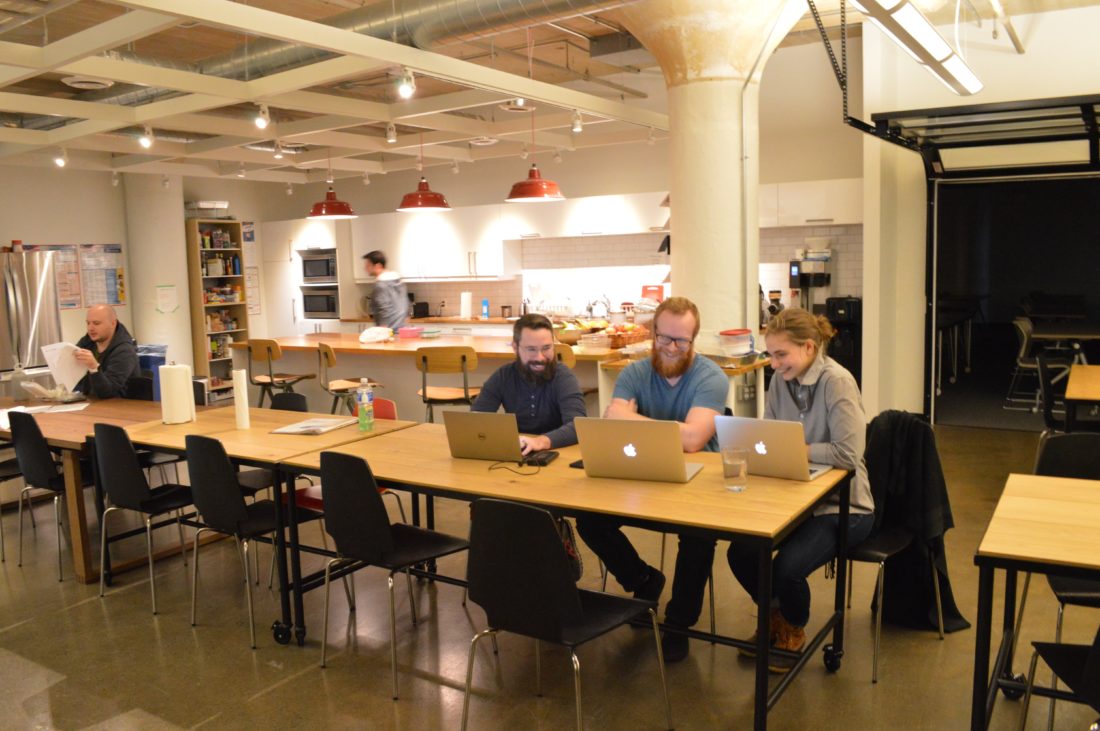UX Design Lead Matt Williams came to Azavea after running his own startup.
He stumbled upon Azavea in a way other team members have, at a tech job fair. After two years, Williams has been continuously challenged with every project. It’s what keeps him at the Callowhill GIS firm — along with the curious, smart and kind coworkers, individual research time and the mapping company’s environmentally conscious mission.
He tells us:
Before joining Azavea, I was running my own business and working 18-hour days. I went to a job fair and met Robert [Cheetham], Azavea’s CEO there. He was the only person at the fair who had a real conversation with me versus a sales pitch. He invited me to come into the office the following day and told me about the company. I didn’t know too much about mapping at the time but thought it was a cool opportunity, so I landed here.
After a couple years, I’m now the UX design lead. I was actually just promoted to this position. Essentially, I’m the point person for any design-related questions that come up, from client work to internal projects. On top of that, I have my own set of five or six projects.
We spoke to Williams about his job, but first, if you’re interested in joining his team, Azavea is currently hiring a UI/marketing designer.
Read on to hear about the “incredibly confusing” concept he’s had to learn on the job, why he bikes to work every day and how his team is spending its “10 percent time,” time that Azavea encourages its staff to spend on personal research and learning.
What is the split between client work and internal projects, and who makes up your team?
Our current workload is comprised of roughly 75 percent client projects. The final 25 percent is a mix between internal projects and marketing efforts. We have somewhere in the ballpark of 15-20 active client projects that are split between myself, Jeff Frankl and Scott Lederer. It’s a manageable workload and will continue to grow with new and exciting challenges, which is why we’re looking to evolve our team.
Each member of the design team will typically lead on one or two internal projects, but that can change frequently due to our flexible sprints.
The 10 percent time for research and learning has been pretty valuable. Jeff is currently spending his 10 percent time pairing with developers from our Civic Apps team to expand his knowledge of developing with ReactJS. In the past, we spent this time creating an Azavea-flavored basemap and a front end framework to use across our mapping applications. I love having that time to be able to come up with new ideas without a client or expectations to make a large profit.
How would you describe these projects compared to other work you’ve done?
Actually, these projects are some of the hardest projects that I’ve ever had to work on in my life. Before I started here, I was primarily doing typical web design and working on my own startup. Here, I’m involved in this world of geo-based applications. It took me by surprise with how difficult it can be.
I’m currently working as a lead on a grant project named Raster Foundry, in partnership with NASA and the U.S. Department of Energy. I’ve had to learn things that I never thought existed. Specifically, I had to learn the concepts of map algebra. It’s an incredibly confusing concept being taught to graduate students. I have a bachelor’s degree.
These are things I never would have thought about in school or at my old job, things that have put me past what I thought were my limits. I’ve grown a lot more since starting at Azavea.
Now that you’re working with geospatial applications for a living at Azavea, what do you love about mapping?
The challenge. There’s really nothing else like it when it comes to web design or development. It’s a whole different way of thinking. Typically, for web design, you get copy or images that you have to put together on a page. With web mapping, there’s a whole different element of interactivity that you don’t even get the chance to explore most of the time.
Are there any perks you might not have expected when you took the job? What else do you admire about working at Azavea?
The fact that we’re trying to play a part in bettering the world as a company is awesome. We keep track of our greenhouse emissions. What other companies do that? That’s incredibly respectable for a company. Now that I’ve been around, it’s opened to my eyes to how much damage a company could potentially put out. I bike to work every single day.
I’m actually doing things that matter and could prove to be really useful in the field. For example, one aspect of the Raster Foundry project is the ability to run calculations on satellite imagery of a recent earthquake and figure out where there’s been heavy damage or alternative routes. There’s a potential to save lives with the work that we’re doing, which is beyond anything I thought I would ever do. It’s pretty exciting.







